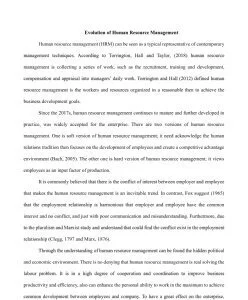Evolution of Human Resource Management
Evolution of Human Resource Management
Evolution of Human Resource Management
Human resource management (HRM) can be seen as a typical representative of contemporary management techniques. According to Torrington, Hall and Taylor, (2018) human resource management is collecting a series of work, such as the recruitment, training and development, compensation and appraisal into managers’ daily work. Torrington and Hall (2012) defined human resource management is the workers and resources organized in a reasonable then to achieve the business development goals.
Since the 2017s, human resource management continues to mature and further developed in practice, was widely accepted for the enterprise. There are two versions of human resource management. One is soft version of human resource management; it need acknowledge the human relations tradition then focuses on the development of employees and create a competitive advantage environment (Bach, 2005). The other one is hard version of human resource management; it views employees as an input factor of production.
It is commonly believed that there is the conflict of interest between employer and employee that makes the human resource management is an inevitable trend. In contrast, Fox suggest (1965) that the employment relationship is harmonious that employer and employee have the common interest and no conflict, and just with poor communication and misunderstanding. Furthermore, due to the pluralism and Marxist study and understand that could find the conflict exist in the employment relationship (Clegg, 1797 and Marx, 1876).
